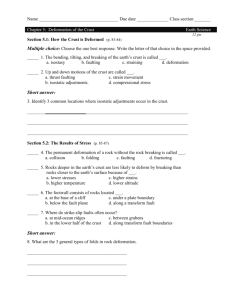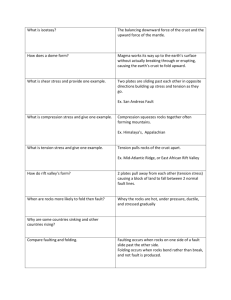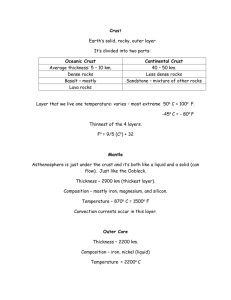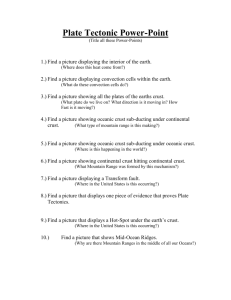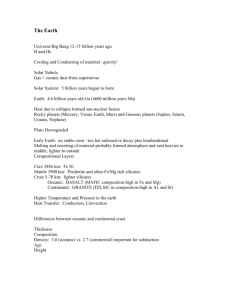Chapter 5
advertisement
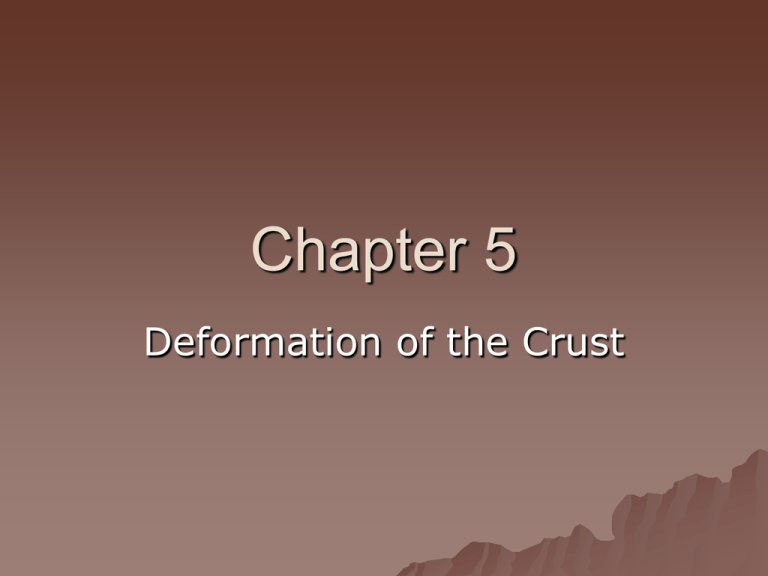
Chapter 5 Deformation of the Crust Section 5.1 Some changes in the earth’s crust occur because of changes in weight of some part of the crust. When parts of the crust become thicker and heavier, they will sink. If they become lighter and thinner, it will rise. Section 5.1 The balancing of the mantle pushing up and the crust pushing down is called isostasy. The up and down movements of the crust is called isostatic adjustments. Section 5.1 Isostatic adjustments are constantly happening. The wearing away of rocks can reduce the height and weight of a mountain. Section 5.1 Rivers can carry large amounts of mud, gravel, and sand into an ocean and pile up. Adjustments can also be found where glaciers once covered the land Section 5.1 Crustal stress occurs when plates collide, separate, or rub together. Strain is a change in the shape or volume of rocks because of the stress of being squeezed, twisted, or pulled apart Section 5.1 Compression occurs when crustal rocks are squeezed together Tension pulls rocks apart Shearing pushes rocks in opposite directions Section 5.2 Folding of rocks occurs when rocks are permanently deformed but no broken 3 types of folds Anticlines are upward curved folds where the oldest layer is in the center. Like a hill Section 5.2 Synclines are downward folds where the youngest layer is in the center. Like a valley Monoclines are folds where both limbs stay horizontal Section 5.2 Rocks do not always fold. They often break from the stress. If there is no movement in the break it is called a fracture. If there is movement it is called a fault. Section 5.2 A fault plane is the surface of a fault where motion occurs. The hanging wall is the rock above the fault plane The footwall is the rock below the fault plane Section 5.2 A reverse fault causes the hanging wall to move up. A thrust fault is almost horizontal A strike-slip fault is where the rocks are moving horizontally Section 5.3 A mountain range is a group of adjacent mountains with the same general shape and structure A mountain system is a group of adjacent mountain ranges A mountain belt is a group of mountain systems Section 5.3 Mountains can form when Continental crust collides with other continental crust or with oceanic crust. Mountains can also form when oceanic crust collides with oceanic crust. Section 5.3 The highest Mountains Ranges in the world are made of folded mountains that usually are made when 2 continental plates collide. Volcanic Mountains form when molten rock erupts to the surface. Section 5.3 The northern oceanic crust of the African plate, which is the seafloor of the Mediterranean Sea, is still subducting beneath the continental crust of Eurasia. Eventually the Mediterranean Sea will become smaller and smaller and disappear.

